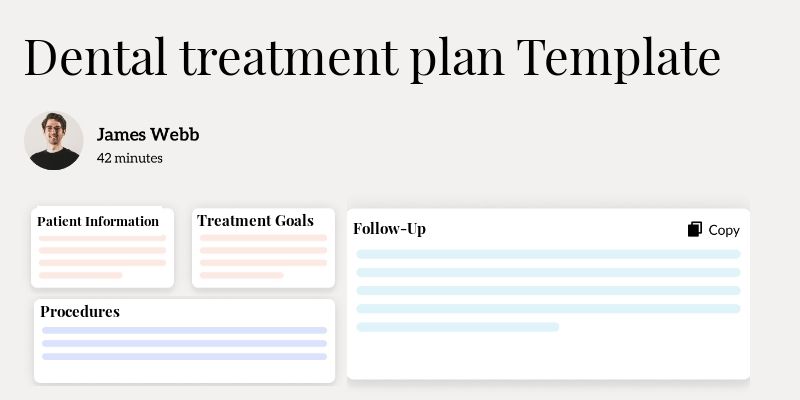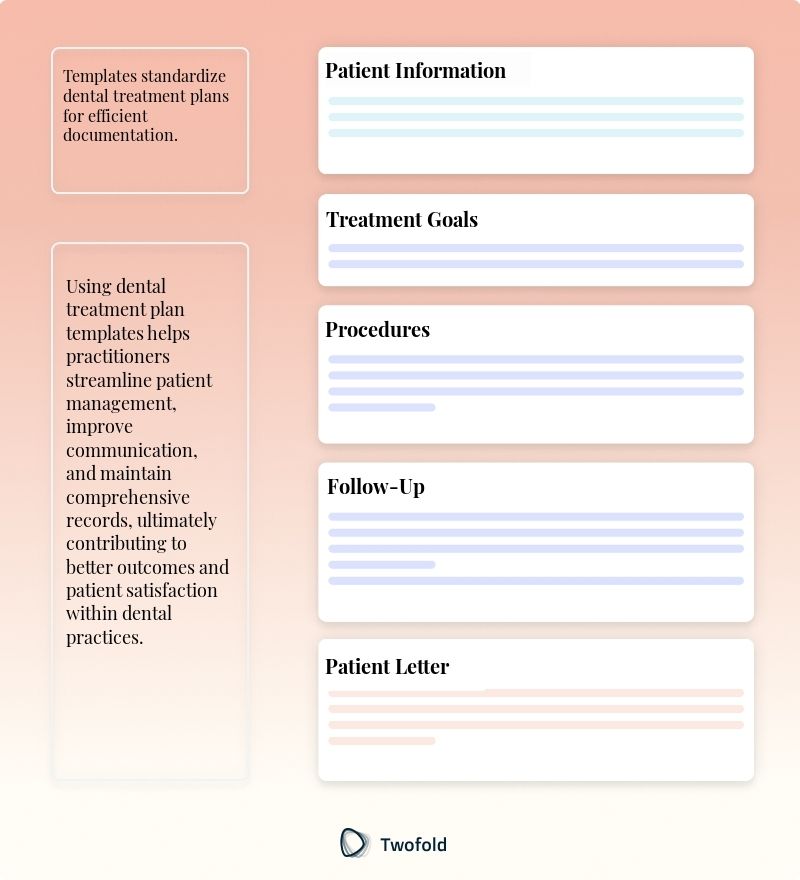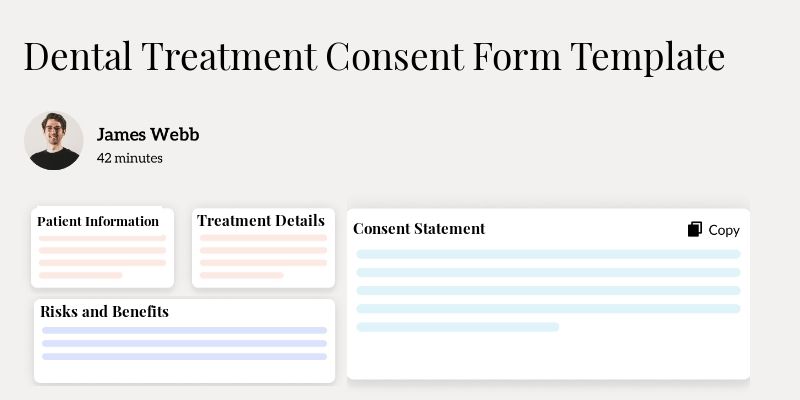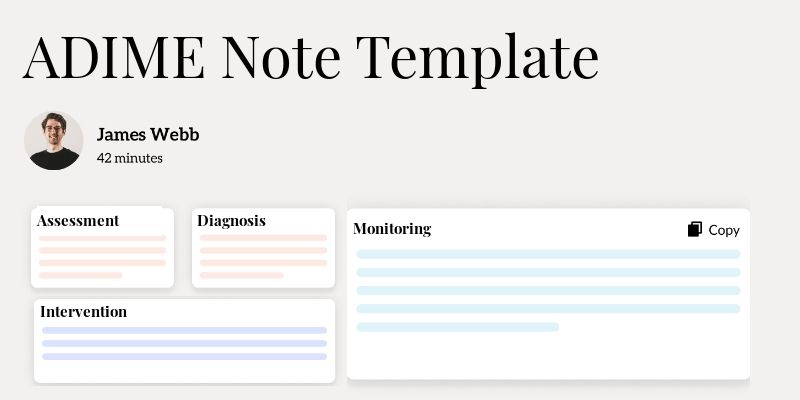
Dental Treatment Plan Template
Welcome to a journey through the heart of dental care documentation. Whether you're a dentist, a healthcare administrator, or an aspiring dental professional, you've probably come across the intricacies of dental treatment planning. It's no secret that crafting a well‑organized and detailed treatment plan is crucial not only for maintaining high standards of care but also for ensuring smooth communication among all involved parties. But what's the secret formula for an effective dental treatment plan template? Let's explore it together.
What Is a Dental Treatment Plan Template?
A dental treatment plan template is a standardized document used by dental professionals to outline the proposed and scheduled dental treatments for a patient. It acts as a blueprint to guide both the practitioner and the patient through the necessary steps to achieve optimal oral health.
The template offers a systematic approach to documenting patient needs, recommended treatments, and anticipated outcomes. This clarity and structure preserve the integrity of care, facilitating better communication between the care provider and the patient.
Key Components of a Dental Treatment Plan Template
The fundamental elements that compose a dental treatment plan template include:
- Patient Information: Personal and contact details for identification and communication.
- Clinical Findings: Documented clinical observations and assessments.
- Treatment Recommendations: Detailed description of suggested treatments.
- Prioritization and Phases: Organization of treatments in phases with prioritizations.
- Cost Estimates: Financial implications and insurance coverage details.
- Patient Consents: Sections for obtaining informed consent for each procedure.

How to Use a Dental Treatment Plan Template: Step-by-Step Process
Step 1: Gather Patient Information
Begin by collecting comprehensive patient data, including medical and dental histories, to inform your treatment planning.
Step 2: Conduct Clinical Assessments
Perform thorough examinations and document findings essential for forming the baseline of your treatment strategies.
Step 3: Develop Treatment Strategy
Compile a list of recommended procedures, aligning them with patient goals and professional standards.
Step 4: Discuss with Patient
Engage the patient in understanding their treatment plan, ensuring their preferences and concerns are addressed.
Step 5: Finalize the Plan
Document the agreed treatment steps, cost projections, and any required follow‑ups.
Benefits of a Dental Treatment Plan Template
Benefit | Description |
|---|---|
Clarity | Provides a clear roadmap of necessary procedures and milestones. |
Communication | Fosters transparent conversations between the dental team and the patient. |
Efficiency | Streamlines the administrative process by reducing redundant documentation. |
Accuracy | Minimizes errors by having all relevant information consolidated in one document. |
Legal Protection | Serves as a legal record of agreed-upon treatments and patient consent. |
Stakeholders in Dental Treatment Plan Templates
Various stakeholders benefit from the well‑structured use of dental treatment plan templates:
- Dentists: Ensures they have a comprehensive and systematic approach to patient care. For example, Dr. Smith noted fewer patient complaints after implementing a standard template.
- Patients: Provides them with a clear understanding of proposed treatments and expected timelines. Jane, a patient, appreciated knowing her treatment plan upfront, reducing anxiety.
- Insurance Companies: Facilitate clear communication regarding coverage and financial planning. An insurance rep cited improved claim processing times with standardized documents.
- Dental Assistants: Assists in preparing and organizing required materials for procedures. An experienced assistant, Alex, reported feeling more prepared for treatments.
Example of a Dental Treatment Plan PDF
For those interested in viewing a sample, a dental treatment plan PDF illustrates how all these elements come together seamlessly.
Real-World Use Cases: Practical Impact of the Dental Treatment Plan Template
Dental treatment plan templates have significant real‑world impacts, seen across various scenarios:
- Dr. Green used the template to streamline communications with lab technicians, ensuring the accuracy of custom dental prosthetics.
- A busy urban clinic implemented a templated approach, quadrupling patient throughput while maintaining the quality of care.
- New patients, like Michael, saw the benefit of having a clearly laid out treatment pathway, increasing his confidence in switching dental providers.
- A rural dental practice improved its patient education efforts, using sectioned plans that highlighted each step of treatment.
- An insurance liaison at a large healthcare provider found that templated plans reduced the time required for reimbursement adjudication significantly.
Conclusion
The dental treatment plan template is a vital tool in the dental profession, marrying clarity with efficiency. By incorporating patient information, structured assessments, and clear communication channels, it benefits dentists, patients, and insurance stakeholders alike. Whether enhancing patient confidence or smoothing out administrative processes, these templates are critical in delivering top‑quality dental care experiences.
Disclaimer: This article is for informational purposes only and does not constitute legal or medical advice. Always consult professional guidelines and regulatory bodies for specific compliance requirements.

Dr. Danni Steimberg
Dr. Danni Steimberg is a pediatrician at Schneider Children’s Medical Center with extensive experience in patient care, medical education, and healthcare innovation. He earned his MD from Semmelweis University and has worked at Kaplan Medical Center and Sheba Medical Center.
A dental treatment plan must guide care, coding, and patient buy‑in—often in a single page. The Stage‑Sequence‑Share method, polished in busy multi‑chair clinics, keeps plans lucid and commitment‑worthy.
- Stage by Quadrant & Urgency: Group findings (e.g., “UR quadrant: #3 MOD decay, priority 1”) so patients and insurers instantly see why some procedures can’t wait.
- Sequence with Codes & Time: Map each visit to specific CDT codes and chair time (“Visit 2: D2392 40 min”)—this clarity streamlines scheduling and pre-authorizations.
- Share Cost & Alternatives Up Front: Pair each procedure with estimated insurance and out-of-pocket costs plus a lower-intensity alternative when possible; transparent options boost acceptance and reduce later rework.
Frequently Asked Questions
Reduce burnout,
improve patient care.
Join thousands of clinicians already using AI to become more efficient.

Dental Treatment Consent Form Template
Discover practical Dental Treatment Consent Form Template templates to enhance your documentation efficiency.

ADIME Note Template
Discover practical ADIME Note Template templates to enhance your documentation efficiency.

Notice of Privacy Practices Template
Discover practical Notice of Privacy Practices Template templates to enhance your documentation efficiency.

